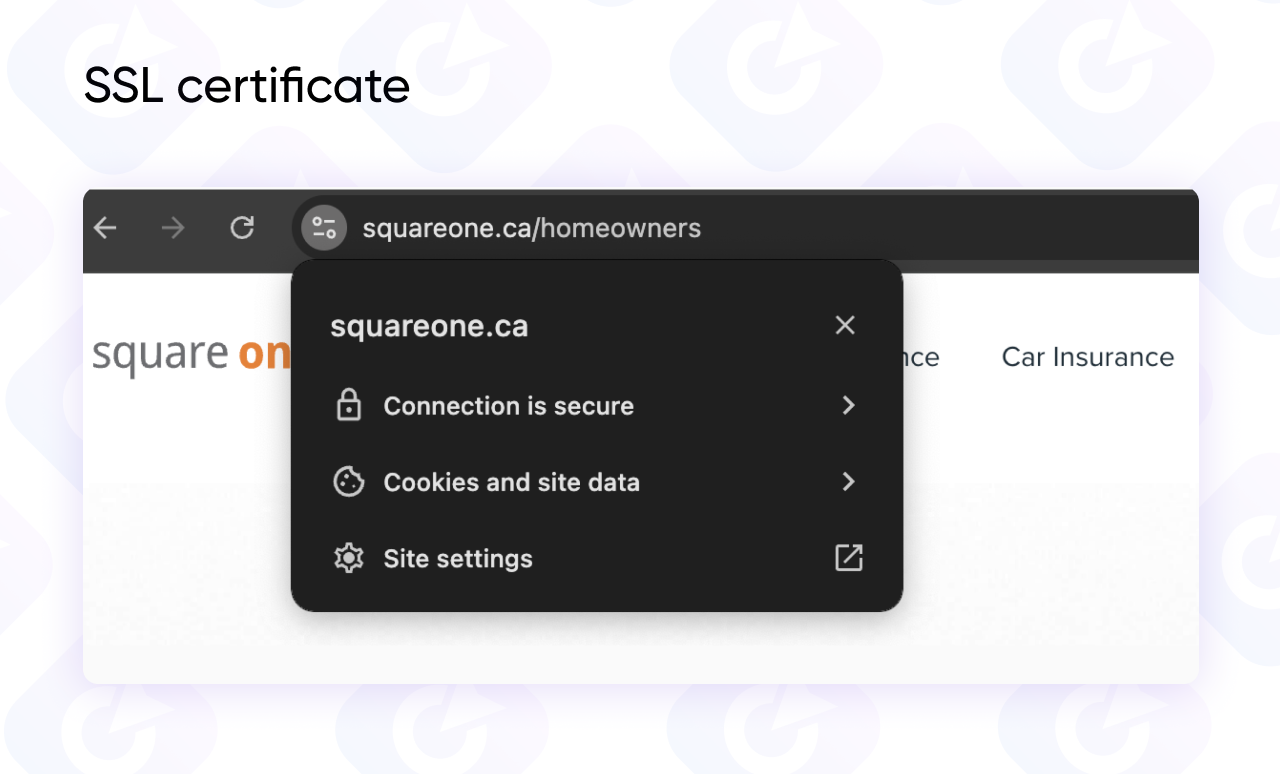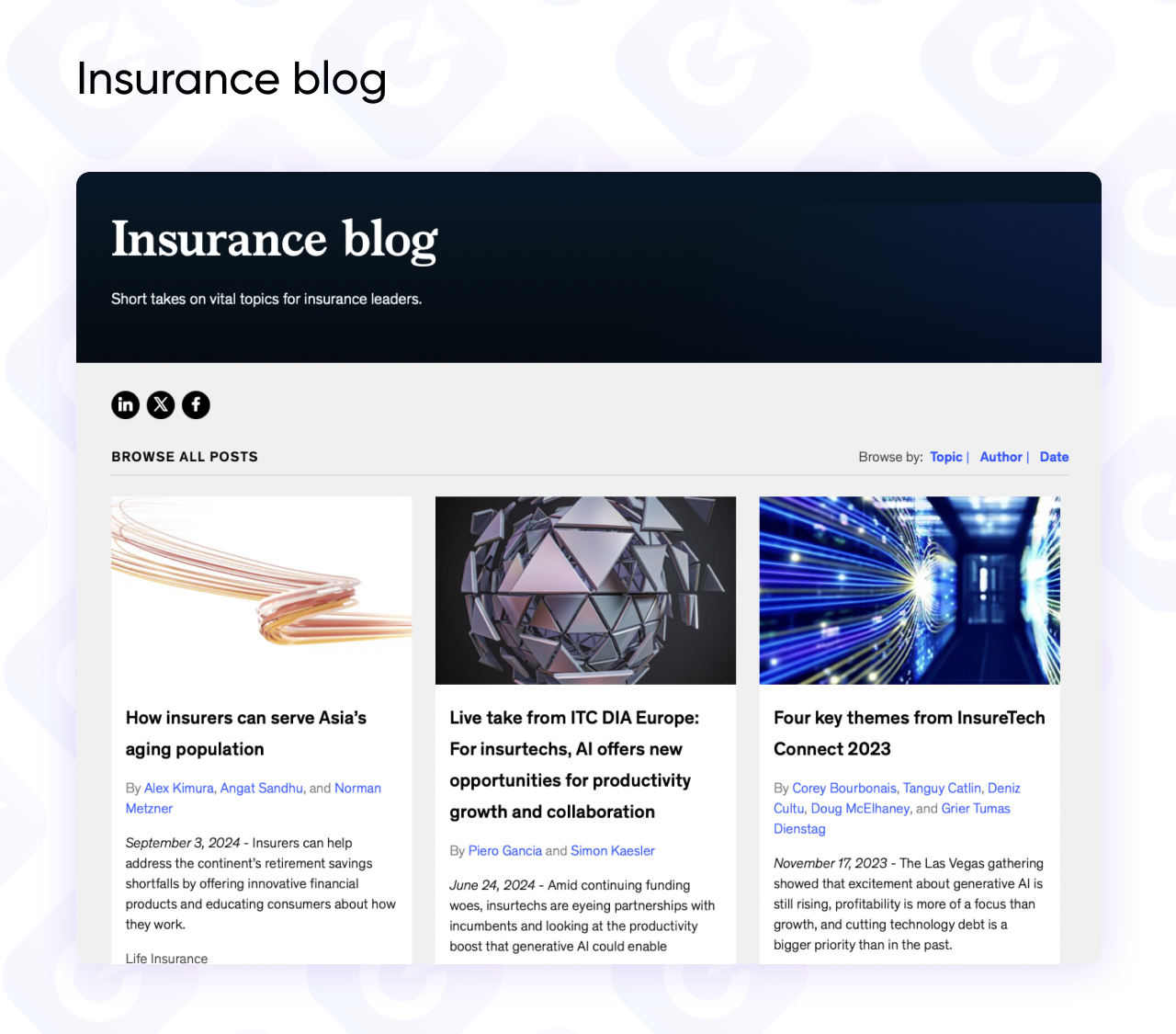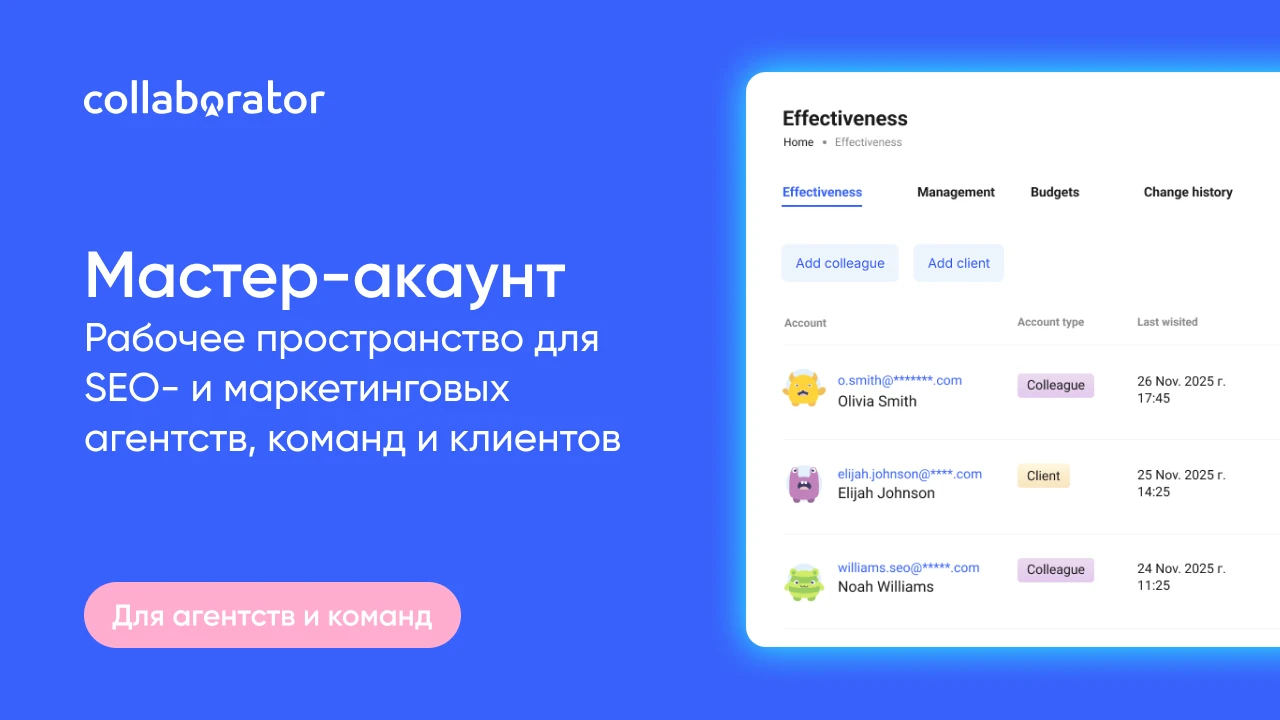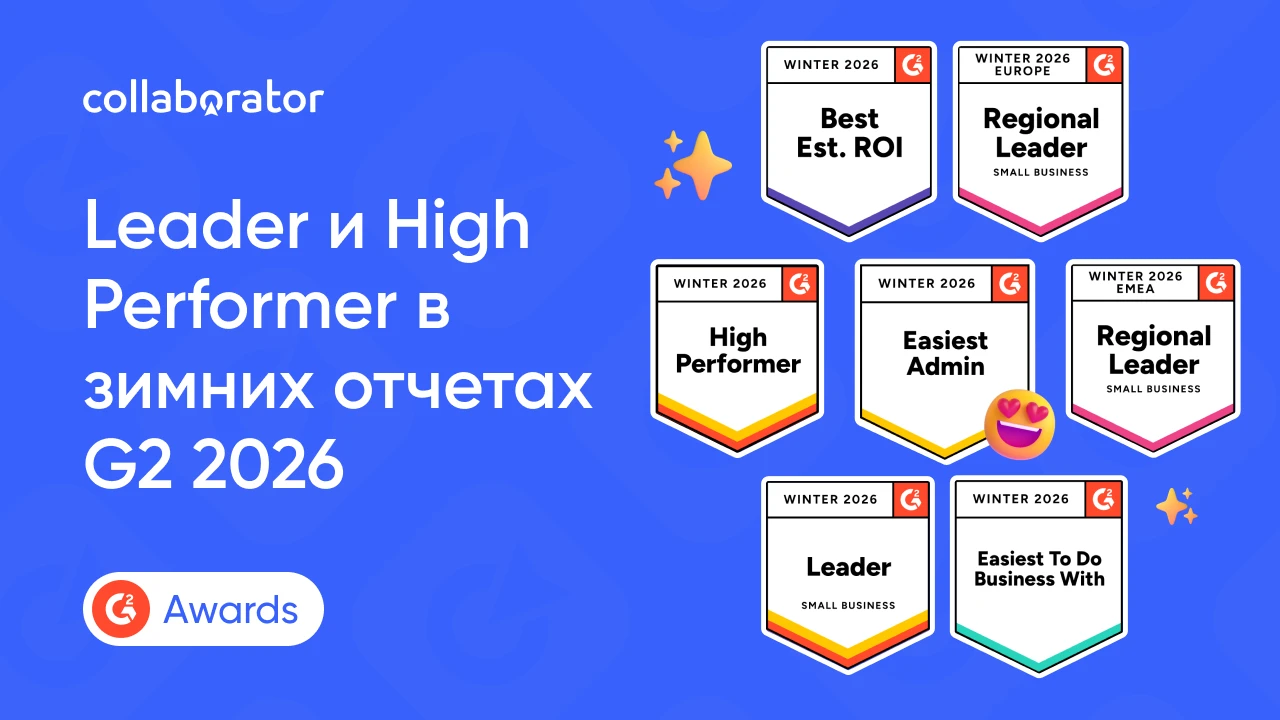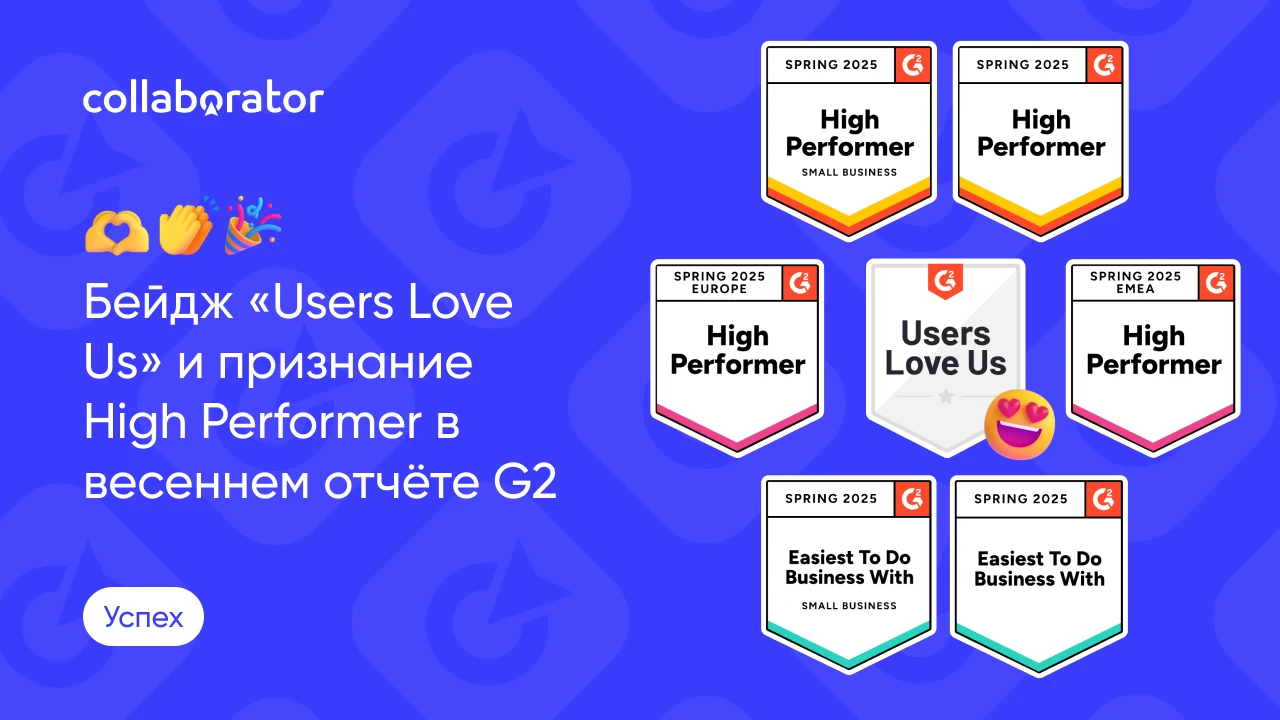
And, of course, you do not want your insurance business to get lost in the sauce SERPs. This is why we're here today: to help you transform an insurance agency website from a needle in a haystack into a magnet that pulls all the needles to it.
So buckle up cause we're about to embark on a wild ride along with Amimul, an Insurance Business SEO Expert.

Why is SEO Important for Insurance Companies?
Before we dive into the practical part, let's talk numbers. Did you know that (according to a 2023 research by First Page Sage) the first link you see in SERPs takes more clicks than results #3 and #10 combined, and the top three organic search results take 68.7% of all clicks? Maybe even less now (thanks to the new Google's Quick View feature that is currently being tested out).
If you’re still not sure why SEO is important for your insurance agency, here are some more pros.
- Increases Visibility in Search Results
As you know, insurance is a highly competitive industry, with many companies competing for visibility in search engines like Google (once again, see the stats above). SEO helps insurance companies rank higher in search results, making them more visible to potential clients who are searching for policies and services. - Drives High-Quality Traffic
In contrast to paid advertising, SEO helps attract customers who are actively searching for insurance-related information, making the traffic highly relevant. This means that visitors are more likely to convert into clients because they already have a need for insurance products. - Builds Trust and Credibility
Ranking on the first page of search results, especially for competitive insurance terms, helps build trust and credibility with potential clients. People tend to trust businesses that appear on top because it gives the impression that they are more established and reliable — in fact, 94% of them skip search ads and head straight to organic results. - Improves Local Search Presence
SEO, and local SEO especially, is highly beneficial for insurance agents or smaller firms that rely on clients within a specific geographic area. Optimizing for local searches like "auto insurance in [City Name]" or "local insurance agents" helps businesses attract customers who are specifically looking for local services. - Cost-Effective Marketing
Compared to traditional advertising methods like TV ads or billboards, SEO is a cost-effective way to attract new customers over the long term. While it requires investment in time and expertise initially (mastering PPC takes around three weeks to learn while learning basic SEO can take up to 3 months), organic search traffic is essentially free, and the benefits compound over time as rankings improve. - Supports the Buyer’s Journey
Insurance purchases typically involve a lengthy decision-making process, as customers want to ensure they choose the right coverage — no one wants to cheap out on insurance. SEO can guide potential clients through each stage of the buyer's journey, from awareness (researching types of insurance) to consideration (comparing policies) to decision-making (choosing a provider). - Helps Manage Online Reputation
A strong SEO strategy includes reputation management, such as monitoring and responding to reviews and ensuring that positive information about the business is visible in search results. This is especially important for insurance businesses, where trust is a critical factor in a customer's decision to buy.
So now that you know the dealio, let us get into the step-by-step SEO guide for insurance.
Perform Keyword Research & Make Informed Decisions
This is one of the most crucial steps for your SEO strategy. Using keyword research tools like Ahrefs, Google Keyword Planner, and Also Asked, find relevant short-tail and long-tail keywords. If you're already confused and thinking, "What the hell are those?" here's the basic explanation: short-tail keywords are broader and more general, and long-tail keywords are highly specific. In our case, "what is covered under travel insurance" would be the long-tail keyword, and "travel insurance" would be a short-tail one. Ideally, you need to have both.
A great addition would also be to add local keywords (if you are operating locally), like "home insurance in [City name]. Pro tip: most of your keyword research may come from analyzing your competitors. The idea behind the whole ordeal is to understand how your potential clients are looking for your services and optimize your insurance site and content according to them.
So, now that you have your keywords ready, it's time for the next step.
On-Page Optimization: Your Digital First Impression
Meta Titles & Title Tags
Imagine you're speed dating, but instead of people, you're trying to impress Google. Your meta title is your opening line, and you've got about 60 characters to make it count.
Here's the comparison of two snippets, one of them being in top-3 organic results for "home insurance" and one of them being on page 10.
Here's how to nail it.
-
Be clear and concise
Ideally, your title should be around 50-60 characters, and your meta descriptions around 150-160. Ensure that both are keyword-optimized and are relevant to the page's content; otherwise, both Google and your customers will definitely get confused. -
Include your main keyword
If you're targeting "home insurance," make sure it's in there! It should look something like "Affordable Car Insurance in [City] | [Your Company Name]" - Make it snappy
"Life Insurance That Won't Cost You an Arm and a Leg (We Promise!)". This will help you stand out from the crowd of not-so-original search results.
URLs & Headers
The principle is the same as above: optimize them with your keywords, but keep in mind that, first of all, your content is for people, not search engines. Therefore, try to strike a balance between optimization and user experience. A golden rule is to have your main keyword in the page URL (e.g., www.myagency.com/auto-insurance), as well as try and add them naturally to your H1, H2, H3, and so on.
Image Optimization
Pro tip: optimize your images, too. You may think, what kind of images would I use for the insurance business, and why should I bother? Well, there's a number of reasons.
First off, it's page speed. We'll dive more into this part later, but here's a quick fact: unoptimized images can contribute to 75% of a page's weight.
Second, images hugely impact user experience. Because who wants to read a full wall of text? See how we're incorporating images into our article (very demure, very mindful)?

A little guide on how to optimize your images for SEO.
And last but not least, by incorporating SEO-optimized images into your strategy, you're also able to rank for Google Images, which, we'd say, is a pretty nice addition.
One of the most crucial things to keep in mind when optimizing your images is to have descriptive filenames and alt texts, but there's a lot more to it.
Check out our guide on image optimization to dive deeper into the topic.
Technical SEO: Because Ain't Nobody Got Time for Laggy Websites
Now that we’ve covered the basics, it’s time to dive a bit deeper, so let’s get physical🎵 technical. Don’t worry, it’s not as scary as it sounds.
Site Speed
First of all, we're coming back to the site's speed. This is, while often overlooked, one of the most crucial factors both for Google and your potential customers. In the age of TikTok and goldfish attention spans, a slow website is SEO suicide. Because nothing bugs us more than a website that takes forever to load.
Did you know that an average site takes 27.3 seconds on mobile and 10.3 seconds on the desktop to load up, and the visitors are 32% more likely to bounce if it increases by 1-3 seconds?
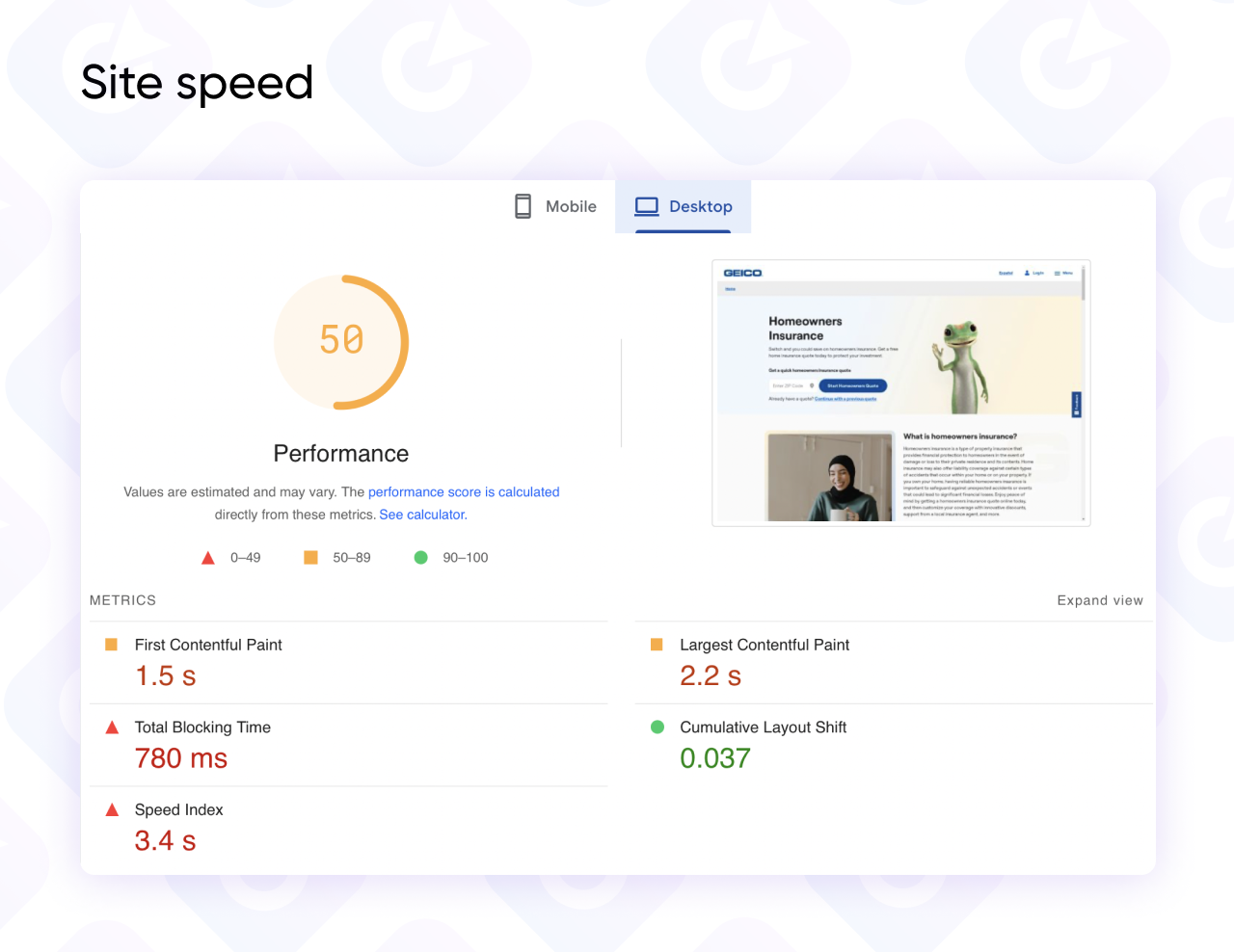
Geico Insurance, being one of the first organic search results for "homeowners insurance," passes Google PageSpeed Insights analysis with only a 3.4 seconds speed index — still being highlighted in red, indicating that it still needs improvements.
Here's how you can test and optimize the site's speed:
- Check your site's speed
Use tools like Google PageSpeed Insights, GTmetrix, and Pingdom Website Speed Testing to check a website's speed and see if an improvement is needed. - Compress images
No one needs to see every pore on your stock photo insurance agent's face. Compress those down! - Enable browser caching
So visitors don't have to download your entire site every... single... time. - Use a CDN (Content Delivery Network)
It's like having a clone of your website strategically placed around the world. Science!
Mobile-friendliness
More than half (a staggering 64%!) of searches come from mobile devices. This means that if a website isn't mobile-friendly, you're basically telling half your potential customers to take a hike.
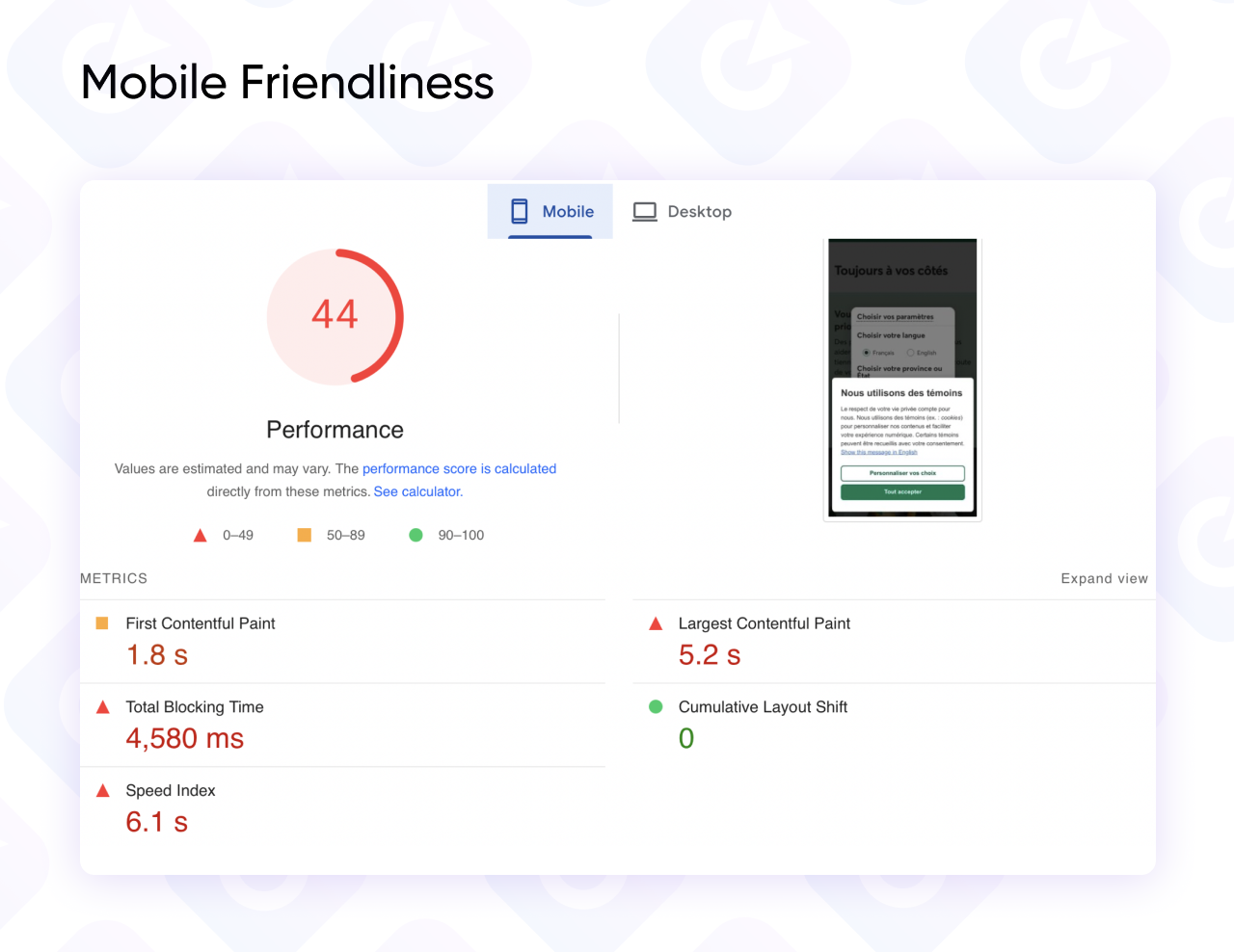
You can use the same Google PageSpeed Insights to check if a website is mobile-friendly.
Here's how to ace the mobile game:
- Use responsive design
Your site should look good on everything from a 27-inch iMac to a flip phone from 2005 (well, maybe not really, but you got the idea). - Simplify navigation
Big fingers + tiny buttons = frustrated customers. - Prioritize mobile-first indexing
Google cares more about how your site looks on phones than on desktops. It's not fair, but neither are a lot of things. It's the way she goes!
SSL Certificates
Use HTTPS to secure your site — this not only is favored by Google, but will provide your customers with a safe mind. That little padlock in the address bar reassures visitors that their data is secure, which is especially important when handling sensitive information like insurance quotes and personal details.
How to set up SSL:
- Purchase an SSL Certificate
Get one from a trusted provider like Let's Encrypt, Comodo, or your hosting provider. - Install the SSL Certificate
Follow your hosting provider's instructions to install the certificate on your server. - Redirect HTTP to HTTPS
Ensure that all traffic automatically redirects to the secure version of your website.
Sitemaps
Create and submit an XML sitemap to help search engines index your pages. It's like giving Google a map of a website, so nothing important gets missed. A well-structured sitemap ensures that your key pages are crawled and indexed properly.
How to create a Sitemap:
- Use a Sitemap Generator
Use tools like Yoast SEO for WordPress or XML-sitemaps.com to generate a sitemap automatically. - Submit to Google Search Console
Log in to Google Search Console and submit your sitemap under the "Sitemaps" section. - Update Regularly
Refresh your sitemap when you add new pages or update existing ones to keep Google informed.
404s & Redirects
Regularly check for broken links or 404 errors to keep the site running smoothly — no one likes hitting a dead end. Using redirects properly ensures that users and website crawlers are guided to the right place, which can help retain traffic and improve your insurance agency SEO.
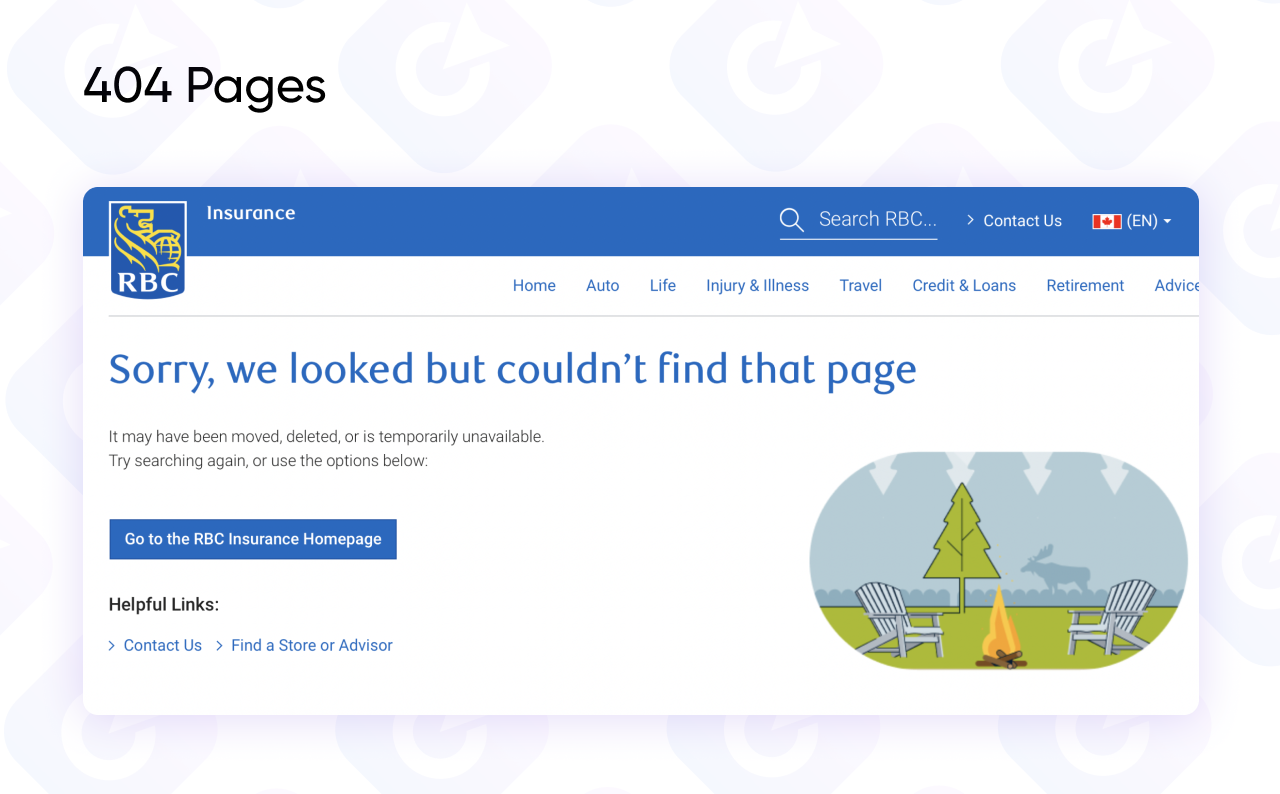
A good example of a properly set 404 page explains what happened and the possible reasons for it and provides you with an option to either go to a homepage, contact support and search for a store or advisor.
How to manage 404s and redirects:
- Use Google Search Console
Check the "Coverage" report to identify 404 errors and broken links. - Set Up 301 Redirects
Redirect broken links to relevant pages or your homepage using 301 redirects. This ensures visitors land on a helpful page instead of hitting a dead end. - Create a Custom 404 Page
Make a user-friendly 404 page with helpful links or a search bar to guide users back to key areas of your site.
Off-Page & Local SEO: Building Your Digital Presence Beyond Your Website
So, you've nailed your on-page optimization and technical SEO. What's next? It's time to go beyond your insurance site and establish your insurance business's presence in the online world. This is where off-page and local SEO comes into play.
Off-Page SEO: Online Networking
Off-page SEO is the digital equivalent of networking at industry events. It focuses on enhancing the site's authority and trustworthiness through external factors. When others vouch for your expertise, you gain credibility in the eyes of Google (this also comes from building backlinks, which is basically a part of your off-page SEO strategy, but more into that later)
- Social Media Engagement
Social media platforms are not just for sharing memes; they're also a great way to connect with potential clients. Engage with your audience by sharing informative content, responding to comments, and participating in discussions. The more active you are, the more likely you'll attract followers and potential customers. - Online Reviews
Reviews play a significant role in your business reputation, especially in the insurance industry. Encourage satisfied clients to leave positive reviews on platforms like Google My Business, Yelp, and Trustpilot. Responding to reviews, both positive and negative, shows that you value client feedback and are committed to providing excellent service. - Guest Posting
Write guest posts for reputable blogs in the insurance or finance sectors. This not only showcases your expertise but also allows you to reach new audiences. Make sure to include a link back to your website, driving traffic and improving your authority in search engine rankings. - Influencer Collaborations
Partnering with industry influencers can significantly boost your visibility. When influencers share your content or promote your services, it introduces your business to a broader audience. Choose influencers whose values align with your brand to ensure authentic promotion. - Forum Participations
Join online forums and communities related to insurance, such as Quora or Reddit. By providing insightful answers and contributing to discussions, you establish yourself as an expert and can link back to your website for more in-depth information.
You can also find these off-page SEO strategies and off-page SEO tools helpful, so be sure to check them out!
Local SEO: Getting Found by Your Neighbors
If you're an insurance agent or agency serving a specific geographic area, local SEO is your secret weapon to stand out in SERPs and connect with more clients. It's all about making sure you're seen when potential clients in your area are searching for services like yours.
Here are some easy steps to make it happen.
- Google My Business (GMB) Profile
First things first, claim and optimize your GMB listing. Make sure your business name, address, phone number, and website are 100% accurate. Upload high-quality images and — this part is key — encourage clients to leave reviews. A solid GMB profile is like your ticket to the top of local search results and Google Maps. Without it, you're basically invisible. - Local Keywords
Incorporate local keywords into your content! We're talking "auto insurance in [City Name]" or "best home insurance in [Neighborhood]." Add these to your content, and you'll be on your way to ranking for searches that matter — clients in your area looking for your services. It's like putting a neon sign up in your town but online. - Citations
Get your business on local directories like Yelp, Yellow Pages, and Angie's List. Make sure your info is consistent across all platforms. This builds trust with Google and helps your rankings. And don't just stop there — create content that makes you the local hero. Write about neighborhood events and your community partnerships, and drop some insurance-related tips that only a local would know. Show Google you're the expert in your market, and your audience will follow. - Localized Content
Create content that resonates with your local audience. This could include blog posts about local events, community partnerships, or insurance-related tips relevant to your area. Localized content helps you connect with your audience and shows search engines that you're an authority in your market. - Engage with Community
Sponsor a local event, join community service projects, or host something yourself. Then, make sure you're blasting it all over your website and socials. This shows that you're more than just an insurance agent; you're their insurance agent. Plus, those local backlinks you'll score? They are the key.
Now, let us talk a bit more about those.
Backlinks: The Building Blocks of SEO Authority
Backlinks. Arguably the most vital aspect of off-page SEO. Backlinks are like votes of confidence from other websites: when reputable sites link to you, it signals to Google that the website is trustworthy and valuable.
Here's how to build an effective backlink strategy.
- Create High-Quality Content
The foundation of any successful backlink strategy is high-quality content. Create informative, engaging, and original content that provides real value to your audience. Infographics, how-to guides, and in-depth articles are more likely to be shared and linked back to by others. - Outreach to Relevant Sites
Reach out to websites and blogs in your industry to promote your content. Offer them something of value in return, like a guest post or collaboration. Tailor your outreach messages to show how linking to your content can benefit them as well. - Monitor Your Backlink Profile
Use tools like Ahrefs or Moz to keep track of your backlinks. This will help you identify which strategies are working and where you might need to improve. Regularly check for toxic links that could harm your site's authority and disavow them if necessary. - Leverage Internal Linking
Don't forget about internal links! These help users navigate your site and signal to search engines which pages are most important. Use descriptive anchor text to create links between related articles and service pages. - Competitor Analysis
Analyze your competitors' backlink profiles to discover opportunities for your own site. Identify sites that link to them but not to you, and reach out with your unique content or insights to encourage them to link to you as well.
By the way (while you're here), Collaborator can simplify this process for you tenfold. With over 37K guest posting platforms from all around the world and incorporated features from top SEO tools like Ahrefs, Moz, Similarweb, and Majestic, the process of building quality backlinks has become so much faster and simpler.
By focusing on off-page SEO, local SEO, and building quality backlinks, you'll pave the way for your insurance business to thrive in the digital landscape.
Content is King: Time to Get Blogging
I know what you're thinking: "Blog about insurance? Isn't that like watching paint dry but less exciting?" Au contraire!
Here's why you should write a blog about insurance:
- It helps you rank for more keywords
The more you write, the more opportunities you have to show up in search results. - It builds authority
Google loves websites that provide valuable information. Be the Wikipedia of insurance! - It answers common questions
"What's covered in home insurance?" is a goldmine of a blog topic.
💡Pro tip: Mix it up! Write listicles ("10 Things Your Car Insurance Probably Doesn't Cover (But Should)"), how-to guides ("How to File an Insurance Claim Without Losing Your Mind"), and even the occasional insurance meme roundup. Yes, insurance memes exist. We checked.
Optimize for New Ways of Search: Voice Search & Conversational AI
In a time where you can simply talk to your phone to get relevant information, search is evolving faster than ever. It's not just about typing your query into Google anymore; voice search and conversational AI like ChatGPT are changing the game.
Instead of scrolling through a long list of search results, your potential clients may be simply asking their devices, "What's the best insurance for my family?" or "Can you find me affordable auto insurance?" This means your insurance agency needs to adapt its SEO strategy to stay relevant and visible in this new landscape.
So, how can you optimize for these emerging search methods? Let us break it down.
Utilize Schema Markup
Schema markup helps search engines understand the website's content better and can improve your chances of being featured in voice search results – not only those, so keep attention even if you think voice search is useless. Implement schema markup on the website to highlight important information, such as your services, FAQs, and contact details. This can enhance your visibility and increase the likelihood of your business being chosen as a source for voice search answers.
Understand Natural Language Queries
Voice searches often use natural, conversational language. People tend to phrase their queries in full sentences, unlike the concise keywords they type. To optimize for this trend, incorporate natural language and question-based keywords into content. Instead of just focusing on "auto insurance," consider targeting phrases like "What is the best auto insurance for young drivers?" or "How can I save on home insurance?" This approach will help you connect better with potential clients searching for information more conversationally.
Focus on Featured Snippets
Featured snippets are the short answers that appear at the top of Google SERPs, often triggered by voice searches. To increase your chances of being featured, structure your blog content to answer common questions clearly and concisely. Use bullet points, numbered lists, and direct answers to questions to make it easier for search engines to pull your content as a snippet. For instance, a section titled "FAQs About Home Insurance" can directly address common questions, positioning your business as a trusted resource.
Optimize for Chatgpt
ChatGPT isn't just a fancy chatbot — it's becoming the new Google for many folks out there. Your future clients might be already asking it about insurance instead of scrolling through endless search results. While ChatGPT can't directly peek at the website, it learns from what search engines have gobbled up, so the same rules apply here: use structured data, tackle real questions people ask about insurance, and keep your website (and content) fresh and up to the latest industry standards.
Tracking & Monitoring: Keep Your SEO Strategy on Point
If you're serious about making your insurance business the go-to name in your area, then listen up: tracking your SEO performance isn't optional. It's the GPS guiding your website to the top of the search results. You'll learn what's working, where you're slipping, and how to tweak your strategy for real results.
Here's what to zero in on, the best tools to get the job done, and how to set up a foolproof tracking system.
Key Metrics to Monitor
-
Organic Traffic
This is your bread and butter: track how many people are finding you through search engines. Google Analytics is your best friend here. - Keyword Rankings
Wanna know where you stand? Keep an eye on your top keywords with tools like Ahrefs or Moz. See what's climbing, what's tanking, and pivot accordingly. - Conversion Rates
It's not enough to get clicks, you want people filling out those quote forms or booking calls. Track how many visitors are taking those key actions to see if your site's doing its job. - Bounce Rate
If folks are bouncing faster than a rubber ball, that's a red flag. It means your content might not be hitting the mark. Find out where they're dropping off and fix it. - Backlinks
Quality over quantity, people. The more solid backlinks you have, the more Google loves you. Use tools like Moz or Ahrefs to see who's linking to you and if they're helping or hurting.
Tools for Effective SEO Tracking & Monitoring
- Google Analytics
For comprehensive insights into your website traffic, user behavior, and conversion tracking. - Google Search Console
To monitor your site’s performance in search results and troubleshoot issues. - Ahrefs
A powerful tool for tracking backlinks, keyword rankings, and overall site health. - Moz
Provides SEO insights and tracks keyword rankings while offering suggestions for improvements. - Racoon SEO Link Checker
A free link tracking extension that helps you quickly find and assess the backlinks in a couple of clicks.

Here's a lil' guide on how to use SEO Racoon Link Checker, a free Chrome extension. You can also watch a step-by-step guide for more detailed instructions.
How to Implement Tracking
Step 1: Set Goals in Google Analytics
You're not just counting clicks, you want to track what really matters. Set up goals for things like form submissions or quote requests so you know what's converting
Step 2: Get on a Reporting Schedule
No more flying blind. Set aside time weekly or monthly to dive into your metrics. You'll spot trends faster than you can say "SEO strategy" and can make data-backed decisions.
Step 3: Adjust & Adapt
SEO is a living, breathing thing. If a keyword is bombing, do not just sit there — switch gears. Use your data to tweak your content or target new keywords and keep that momentum going.
You can also find more detailed, step-by-step instructions for Google Analytics 4 for SEO & how to use other tools for backlink tracking in our recent articles.
The Bottom Line
Insurance is a cutthroat game, and you can't afford to slack on tracking your SEO. Focus on the metrics that matter, use the right tools, and stay on top of your game with regular check-ins.
Remember, SEO isn't a one-and-done — keep adjusting, keep refining, and watch your rankings and client list grow.




